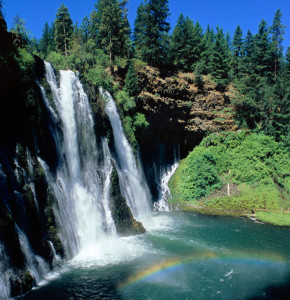Note from Storm: If you’ve read my new Success Guide, you know that the magic formula for revitalizing places often boils down to three words: repurpose, renew, and reconnect.
So, you’ll understand my enthusiasm for the Great Shasta Rail Trail project, which repurposes an abandoned railway into a recreational asset, renews the ecology along the corridor, and reconnects communities, most likely revitalizing quality of life and economic health for all.
In a recent conversation with Anne Murphy, Executive Director of the Shasta Land Trust, she told me “Far northern California is an area with rich natural resources, scenic beauty, and abundant recreational opportunities. The 80-mile Great Shasta Rail Trail, which connects the communities of Burney and McCloud, supports the local heritage and culture of the area and boosts the economic and social vitality of these communities. It also provides access into nearby public lands and other trail systems, including the Pacific Crest Trail. It’s a really exciting project and we are thrilled to have been able to play a key role.”
I’ve long been a big fan of land trusts. Many limit there activities to traditional conservation, but more are getting involved in environmental restoration, and in strategies that help revitalize local communities (or make them more resilient). For instance, their Trail Concept Plan says “Enhancing the beauty and ecological health of the corridor will be accomplished by replacing or stabilizing existing culverts and bridges, protecting and restoring sensitive habitats, promoting outdoor learning about nature to enhance the visitor experience, and working with adjoining landowners to reserve visual edges on harvest areas.”
The role of the Shasta Land Trust in this case was that of an acquisition agent. They secured a letter of intent with the railroad as well as $350,000 in funding through the California Transportation Commission’s Environmental Enhancement and Mitigation Program (EEMP). They then took title to the railroad at the end of June, 2015, and are currently in the process of transferring it to a newly-created nonprofit who will own and manage the trail in the long term, the Great Shasta Rail Trail Association.
^^^^^^^^^^^^^^^^^^
The Great Shasta Rail Trail will link the towns of McCloud and Burney and nearby recreation areas along an 80-mile scenic trail featuring local heritage and culture, close connections to nature, and boosting the economic and social vitality of local communities.
Back in the days when the McCloud Railway Company hauled logs and freight between McCloud and Burney, rail service was a vital transportation link between these two communities. The McCloud River Railway Company began operation in 1897 and stimulated the growth of McCloud and Burney as thriving sawmill towns.
Now imagine this historic railroad becoming one of California’s premier long-distance trails for all to use and enjoy. You are invited to share our vision to transform 80 miles of railroad bed to the Great Shasta Rail Trail (GSRT).
We envision the development of trailheads and other visitor facilities that welcome public use, including future trail connectors to year-round recreation opportunities for hikers, bicyclists, equestrians, and other uses.
This project has been pursued by volunteers from several organizations that serve the people of this region, notably Save Burney Falls, Shasta Land Trust, McCloud Local First Network, the Volcanic Legacy Community Partnership, and the McCloud Trails Association. Our work has been supported by the Shasta Regional Community Foundation, the Rails to Trails Conservancy, and the Rivers, Trails, and Community Assistance program of the National Parks Service.
 When fully developed, the GSRT will offer an array of recreation opportunities that will promote healthy lifestyles through exercise, interpretation and education, and trail stewardship activities. The GSRT will be a place of discovery with fascinating tales to ell.
When fully developed, the GSRT will offer an array of recreation opportunities that will promote healthy lifestyles through exercise, interpretation and education, and trail stewardship activities. The GSRT will be a place of discovery with fascinating tales to ell.
Interpretive sites along the GSRT will foster awareness, appreciation, and protection of the trail’s natural, scenic, cultural, and historic resources.
This new recreation resource will boost the economic vitality of the area.
The Great Shasta Rail Trail Association‘s goals are:
- Provide year around recreation opportunities for hikers, bicyclists, equestrians, skiers, and other non-motorized uses
- Promote awareness, appreciation, and protection of natural, scenic, cultural, and historic resources and promote community involvement in their protection and care Incorporate trail designs that mimic the natural, historic, and cultural environment along the trail and promote local stewardship
- Feature a well-maintained primary trail within the railroad right-of-way
- Incorporate safe and easy access from local communities and connections to nearby major recreation areas on adjacent public land
- Promote healthy lifestyles through exercise, interpretation and education, and trail stewardship activities
- Stimulate local recreation that can boost economic opportunities linked to the uniqueness of the area – its environment, culture, heritage, people, and history.
“We are so thrilled that this trail is opening; it’ll undoubtedly be one of the most scenic in California,” said Laura Cohen, director of Rails To Trails Conservancy‘s Western Regional Office. “Bravo to the dedicated group of community advocates led by April Gray [President of the GSRTA Board of Directors]; their tenacity and spirit of volunteerism really made this happen. We should also recognize the many partner agencies, including the National Park Service, that stepped up to turn this vision into reality.”
See article on Shasta Land Trust website.
See the Great Shasta Rail Trail Association website & photo credits.
See July 30, 2015 article on the two people whose vision catalyzed this project.
See September 2015 article on Rails To Trails Conservancy website.

